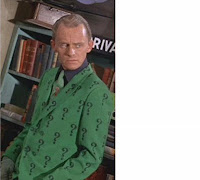Insomnia can be educational. Early risers or the sleep-deprived might want to know that from 5:30-6:00 AM, you can catch Dobie Gillis on one of the Pronoun channels on cable TV-"Us," or "We," I forget which. The episode I saw had Dobie and Maynard both wearing ROTC uniforms. Like, for real. It brought me back to this old post I wrote a couple of years ago. Speaking of re-runs...
Yankee Dog mentioned Frank Gorshin's hep cat role in "Where the Boys Are." I have no doubt that there's a large sub-division of the Academic Culture Industry that has chewed on the subject of jazz/beat portrayals in film and TV like a chia pet on a licorice rope. But boys, if you're reading, try to chill. I'm not trying to grab anybody's dissertation. This is just personal flashback and speculation based on such ephemera as I recall from adolescence.
The steadiest diet of jazz-beatnik-hipster my cohort got was from
Maynard G. Krebs, Dobie Gillis' pal. Each on-screen appearance by Maynard (Bob Denver, who eventually reincarnated as Gilligan) was signaled by a very cool little blues motif played on flute. Maynard (Ferguson, anyone?) threw in an occasional "man" and "cat," but his most salient character trait was, as Washington Irving said of Rip Van Winkle, his "insuperable aversion to any and all kinds of profitable labor." If the notion of getting a job was mentioned, he would stammer out "W-W-W-work?!" He was lovable and ineffectual. If there was any cultural danger represented by jazz-loving beats, Maynard was there to reassure us they represented no real threat.
Gorshin was slightly more threatening because to me, no matter what he played, he always exuded a barely-controlled murderous impulse (see his
'Riddler'). But in "Where the Boys Are, he was an egghead loser, with thick horn rimmed glasses. Shoot-his name was Basil. The rest of the gang was rock and roll. He was jazz and out of it. Impotent over-intellectualizing, thy name is Beat.

In Roger Corman's "Bucket Of Blood," the hapless Walter Paisley kills a few folks and covers them with plaster so he can be accepted as an 'artist' by the crowd at the beatnik coffee house-a dupe of the fast beat crowd. That crowd, while not homicidal, was shown to be steeped in bohemian self-delusion and was really just there for cultural sport. The presence of real jazz musicians Paul Horn and Fred Katz in the house band undermines that conceit-the music's too good.
The only really evil character in the beat movie milieu that I know of was played by Peter Falk in his first big movie role-
The Bloody Brood-1959-same year as Dobie on TV. This is a picture riddled with sado-masochism, and a very confused message. On the one hand, the filmmakers want to blame the wayward milieu of the Beats for
providing ripe soil for evil, and yea, maniac faux-beatnik Falk wanted to get his "kicks" (beat code), but they dressed him in a suit, he smoked a cigar and his name was Nico. The feeble Beats murdered, but only because their lack of will made them powerless to stand up against Falk. Eventually, someone with a sane haircut brought them to their senses.
The final characters in this cultural menagerie are Steve Allen, first host of the Tonight Show and Soupy Sales. Allen was half yenta/half aspiring hipster, a composer and decent jazz pianist who had an odd lot of people on his show, including
Frank Zappa, Lenny Bruce and
Jack Kerouac. Soupy had a serious array of jazz folks on-Hawkins, Armstrong, Bird... Let it be noted that the only Clifford Brown footage I know of is from
Soupy Sales' show. But these guys are less about Hollywood dealing with jazz/beats than the jewish/jazz/hipster conspiracy-a discussion that needs its own space.
In the meantime, I'd be willing to bet my tattered copy of "Howl" that when drugs and beats are part of the plot of any movie made in this era, jazz is the soundtrack-not rock and roll.














